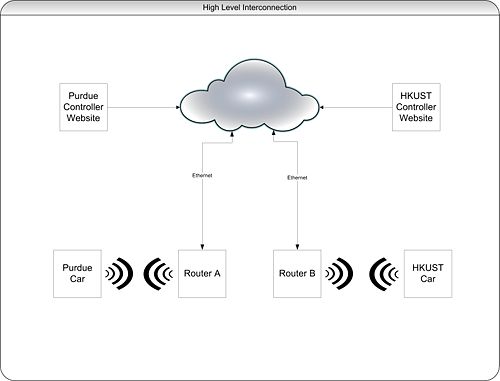| Line 431: | Line 431: | ||
<tr> | <tr> | ||
<td width=800> | <td width=800> | ||
| − | <b>November , 2011 ():</b> | + | <b>November 15, 2011 (3 hours):</b> |
<br> | <br> | ||
| − | + | Met with group to work on our protocol and other projects. Scott, Kin Chin, and Chris worked to develop a protocol that incorporated some of the ideas that the HK group had proposed on the discussions page. <br><br> | |
| + | Meanwhile, I worked on flashing Ubuntu onto an SD card and adding the necessary files to allow it to boot on the Pandaboard. It worked on the first shot! Well, it booted on the first shot. I still had to add about 238MB of other files for the board which, among other things, added the wireless and bluetooth drivers. | ||
| + | <br><br> | ||
| + | I plugged in the webcam obtained from Dr. Swabey and tried running Cheese to see if we could see the video from the camera. It crashed the OS and rebooted. I kept the camera plugged in and tried again but did not get anything. The webcam choice on that app is stuck on /dev/video3 so I will need to do more research to find where the webcam is actually being mounted. | ||
| + | <br><br> | ||
| + | I got back with the rest of the group and we finalized our protocol proposal. Basically, it goes along with the HK teams desire for a 16 bit protocol. The first byte is used for the actual vehicle control. As you can see from the picture, drawn by Scott, there is a bit to signal a right turn, a bit to signal a left turn, and two bits to designate the turn speed. The other four bits will be used for vehicle speed. There are 16 distinct points for vehicle speed that can be utilized, split between forward and reverse. The interpretation of that number (whether signed or unsigned) will be discussed at the video conference. | ||
| + | <br><br> | ||
| + | The second byte will be used for peripheral control. One of the main problems we saw with HK's protocol plan was that the peripheral control didn't make much sense. We decided that the second byte will be split up into two 4 bit values, one designating the peripheral/action and the other being the control value (can be 0 or 1 or a value with higher resolution). We wanted to be able to expand our peripheral control capabilities without having to change the protocol while still keeping the data to 2 bytes. | ||
</td> | </td> | ||
</tr> | </tr> | ||
Revision as of 18:12, 16 November 2011
Contents
Jason Holmes - Design Notebook
Week of Sept. 19 |
|
September 21, 2011 (1.5 hours):
|
|
September 22, 2011 (20 minutes):
|
|
September 23, 2011 (1 hour):
|
| WEEK SUMMARY: Accomplishments: Obtained usernames for HKUST members
|
Week of Sept. 26 |
|
September 27, 2011 (45 minutes):
|
|
September 27, 2011 (30 minutes):
|
|
September 28, 2011 (1 hour):
|
|
September 29, 2011 (45 minutes):
|
|
September 30, 2011 (1.5 hour):
|
| WEEK SUMMARY: Accomplishments: Completed preliminary block diagram layout of system. Decided on potential processor family.
|
Week of Oct. 3 |
|
October 6, 2011 (2 hours):
|
|
October 7, 2011 (1 hour):
|
|
October 7, 2011 (1.5 hours):
|
| WEEK SUMMARY: Accomplishments: Finished poster for VIP poster session
|
Week of Oct. 10 |
|
October 11, 2011 (30 minutes):
|
|
October 13, 2011 (1 hour):
|
|
October 14, 2011 (1.5 hours):
|
| WEEK SUMMARY: Accomplishments: Decided on a development board to begin prototyping.
|
Week of Oct. 17 |
|
October 17, 2011 (30 minutes):
|
|
October 17, 2011 (1 hour):
|
|
October 18, 2011 (3 hours):
IP Camera:TRENDnet TV-IP110WN Wireless N Internet Camera
|
|
October 19, 2011 (2 hours):
|
|
October 20, 2011 (1 hour):
|
| WEEK SUMMARY: Accomplishments:
|
Week of Oct. 24 |
|
October 25, 2011 (3.2 hours):
(640 x 480 pixels) X (2 bytes per pixel) = 614,400 bytes per frame All of the CMOS cameras output in a RGB format or similar - raw image data. For most cameras, this is 16 bits per pixel. Without doing our own compression, this image data would be impossible to send wirelessly. There is a library for C to convert RGB data to JPEG format, which then possibly be converted to MJPEG on the controller side. This could possibly be used on-board, but the speed would have to be tested.
|
|
October 28, 2011 (1.5 hours):
|
| WEEK SUMMARY: Accomplishments:
|
Week of Oct. 31 |
|
November 1, 2011 (4.5 hours):
|
|
November 3, 2011 (7 hours):
|
|
November 3, 2011 (1.5 hours):
|
| WEEK SUMMARY: Accomplishments: Received tanks
|
Week of Nov. 7 |
|
November 8, 2011 (3 hours):
|
|
November 9, 2011 (3 hours):
|
|
November 10, 2011 (2 hours):
|
|
November 11, 2011 (2 hours):
|
| WEEK SUMMARY: Accomplishments: Completed design review
|
Week of Nov. 14 |
|
November 15, 2011 (3 hours):
|
|
November , 2011 ():
|
|
November , 2011 ():
|
|
November , 2011 ():
|
| WEEK SUMMARY: Accomplishments:
|






